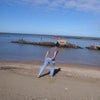Eilat (he-n. אֵילַת Шаблон:Audio) is Israel's southernmost city, a busy port as well as a popular resort, located at the northern tip of the Red Sea, on the Gulf of Eilat. Home to 46,900 people, the city is part of the Southern Negev Desert, at the southern end of the Arava. The city is adjacent to the Egyptian village of Taba, to the south, and the Jordanian port city of Aqaba, to the east.
- approach to Eilat]] Eilat's arid desert climate is moderated by proximity to a warm sea. Temperatures often exceed Шаблон:Convert in summer, and Шаблон:Convert in winter, while water temperatures range between 20 and 26 °C (68-79 °F). The city's beaches, nightlife and desert landscapes make it a popular destination for domestic and international tourism.
Despite harsh conditions, the region supported large populations as far back as 8,000 BCE. Beginning in 1861 ancient sites have been recorded throughout the region, but to date only around 7% of the area has undergone a detailed archaeological survey with around 1500 ancient sites recorded in a Шаблон:Convert area. In contrast to the gaps found in settlement periods in the neighbouring Negev Highlands and Sinai, these sites show continuous settlement for the past 10,000 years.
The geology and landscape are varied: igneous and metamorphic rocks, sandstone and limestone; mountains up to Шаблон:Convert above sea level; broad valleys such as the Arava, and seashore on the Gulf of Aqaba. With an annual average rainfall of Шаблон:Convert and summer temperatures of Шаблон:Convert and higher, water resources and vegetation are limited.
"The main elements that influenced the region's history were the copper resources and other minerals, the ancient international roads that crossed the area, and its geopolitical and strategic position. These resulted in a settlement density that defies the environmental conditions."
The original settlement was probably Eilat at the northern tip of the Gulf of Aqaba. Eilat is mentioned in antiquity as a major trading partner with Elim, Thebes Red Sea Port as early as the Twelfth dynasty of Egypt. Trade between Elim and Eilat furnished Frankincense, and Myrrh, brought up from Ethiopia and Punt; Bitumen and Natron, from the Dead Sea, finely woven Linenfrom Byblos, copper amulets from Timnah, all as mentioned in the Periplus of the Erythraean Sea. Eilat which is now on the border with Egypt, Jordan, and Saudi Arabia was anciently on the border of the states of Edom, and Midian and the tribal territory of the Rephidim the indigenous inhabitants of the Sinai. The commercial port city and copper based industrial center were maintained by Egypt in antiquity until rebuilt by Solomon.
Archaeological excavations uncovered impressive prehistoric tombs dating to the 7th millennium BCE at the western edge of Eilat, while nearby copper workings and mining operations at Timna Valley are the oldest on earth. Ancient Egyptian records also document the extensive and lucrative mining operations and trade across the Red Sea with Egypt starting as early as the Fourth dynasty of Egypt.
Eilat is first mentioned in the Bible in the Book of Exodus in the stations. The first six stations of the Exodus are in Egypt. The 7th is the crossing of the Red Sea and The 9th-13th are in and around Eilat after they have left Egypt and crossed the Red Sea. Station 12 refers to a dozen campsites in and around Timna in Modern Israel near Elat.
When King David conquered Edom, which up to then had been a common border of Edom and Midian, he took over Eilat, the border city shared by them as well. In Kings 2 14:21-22: "And all the people of Judah took Azariah, who was sixteen years old, and made him king in the room of his father Amaziah. He built Elath, and restored it to Judah, after that the king slept among his fathers." And again in Kings 2 16:6: "At that time Rezin king of Aram recovered Elath to Aram, and drove the Jews from Elath; and the Edomites came to Elath, and dwelt there, unto this day".
During the Roman period a road was built to link the area with the Nabataean city of Petra (modern-day Jordan). The remains of a large copper smelting and trading community which flourished during the Ummayad Period (700-900 CE) were also found between what is now Eilat's industrial zone and nearby Kibbutz Eilot.
The Darb el Hajj or "Pilgrim's Road", from Africa through Egypt to Mecca, passed out of Sinai from the west at Eilat before skirting the sea and continuing south into Arabia.
The area of Eilat was designated as part of the Jewish state in the 1947 UN Partition Plan. During the War of Independence an old Ottoman police station, called Umm Rashrash in Arabic, was taken without a fight on March 10, 1949 as part of Operation Ovda, in which both the Negev and Golani Brigades participated. (Only one of Umm Rashrash 's mud-brick buildings remains standing, in its own park.) Having forgotten to bring an Israeli flag with them, the Negev Brigade soldiers improvised and raised the "Ink Flag" in order to claim for Israel the area upon which Eilat would be constructed.
Begun as a military outpost, Eilat quickly grew as the area's resources were surveyed and developed. The Timna Copper Mines were opened and a port constructed, the Eilat Ashkelon Pipeline laid, and tourists began visiting. The Port of Eilat became vital to the fledgling country's development.
After the 1948 Arab-Israeli War all Arab nations maintained a state of hostility with Israel, blocking all land routes; Israel's access to and trade with the rest of the world was maintained by air and sea alone. Further, Egypt denied passage through the Suez Canal to Israeli-registered ships or to any ship carrying cargo to or from Israeli ports. This made Eilat and its sea port crucial to Israel's communications, commerce and trade with Africa and Asia, and for oil imports. Without recourse to a port on the Red Sea Israel would have been unable to develop its diplomatic, cultural and trade ties beyond the Mediterranean basin and Europe.
Such a situation took place in 1956 and again in 1967, when Egypt's closure of the Straits of Tiran to Israeli shipping effectively blockaded the port of Eilat. In 1956 this led to Israel's participation in the Sinai Campaign along with the U.K. and France, and in 1967 was cited by Israel as an additional casus belli leading to the outbreak of the Six-Day War.
In the 1970s tourism became increasingly important to the city's economy as other industries shut down or were drastically reduced. Today tourism is the city's major source of income.
Despite the rise in world terrorism Eilat has been relatively safe, averaging 2-3 incidents per decade for the past 30 years. The last attack, the Eilat bakery bombing, took place in a residential neighborhood of Eilat in January 2007. Шаблон:Wide image
Following peace treaties signed with Egypt in 1979 and Jordan in 1994, Eilat's borders with its neighbors were finally opened. In 2007, over 200 Sudanese refugees from Egypt who arrived in Israel illegally on foot were given work and allowed to stay in Eilat, despite the fact that Sudan is technically still at war with Israel. Eilat's population includes a large number of foreign workers, estimated at over 10,000, working as caregivers, hotel workers and in the construction trades.
Eilat became a free trade zone in 1985.
Eilat is connected to the rest of Israel, and internationally by air, road, sea, and bus. Eilat Airport is located in the city centre, and used largely for domestic flights (domestic code: ETH, international code: LLET). International flights to the city often use Ovda International Airport some Шаблон:Convert northwest of the city.
Eilat has two main roads connecting it with the center of Israel. Egged, the national bus company, provides regular service to points north on an almost hourly basis during daylight hours. There are also two border crossings: the Taba Border Crossing to Taba, Egypt and Wadi Araba Crossing to Aqaba, Jordan; named by Israel as Yitzhak Rabin Border Crossing. Although there is currently no rail network to the city, the Port of Eilat and Eilat Marina allow travel by sea. Near-term plans call for a rail link to substantially decrease travel times from Eilat to Tel Aviv and Jerusalem, via the existing line at Beer Sheba; planning work for this line is already underway.
Eilat's economy is based around leisure and tourism.
Eilat offers a wide range of accommodations - from hostels to luxury hotels - as well as many unique attractions and recreational options within a 50 kilometer (31 mile) radius.
Eilat has streets named after Durban, Kamen, Kampen and Los Angeles as well as a Canada Park. Several Maple trees also grow in various parts of the city.





